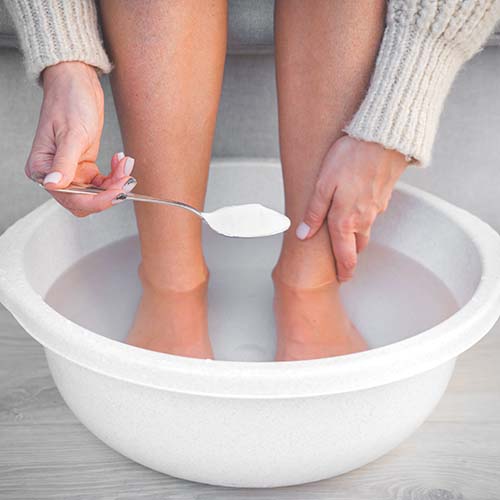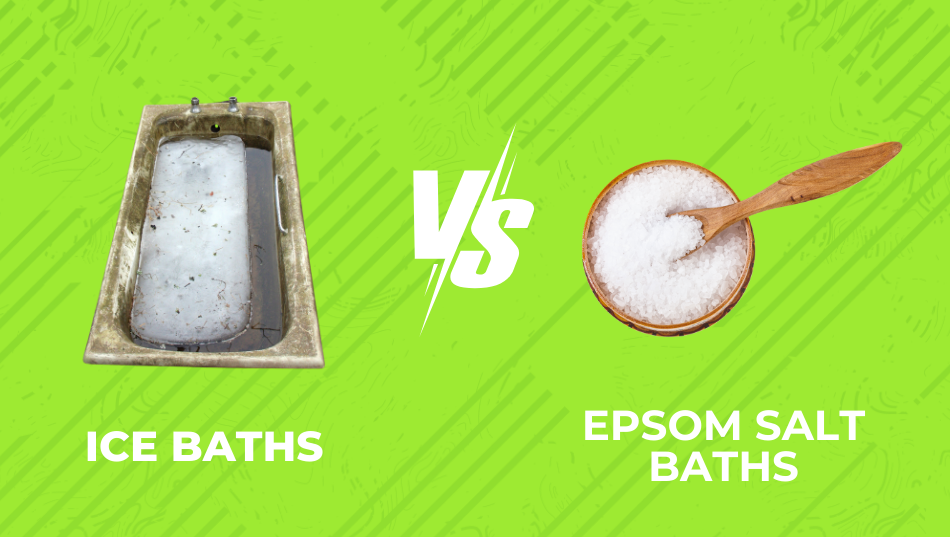Ice Baths vs Epsom Salt Baths for Runners
Table of Contents:
Recovery is a crucial part of any runner’s training regimen. Whether you’re a seasoned marathoner or just getting into the rhythm of regular runs, how you treat your muscles post-run can make a significant difference in your performance and overall well-being. Two popular recovery techniques that runners often consider are ice baths and Epsom salt baths. But which one is more effective for muscle recovery? In this article, we'll explore the benefits of both ice baths and Epsom salt baths, comparing their effectiveness and offering recovery tips for runners to help you choose the best bath for muscle recovery.
Understanding Post-Run Muscle Recovery
After a long or intense run, your muscles are often left feeling sore, tired, and inflamed. This muscle soreness, known as delayed onset muscle soreness (DOMS), typically peaks 24 to 48 hours post-exercise. To mitigate this discomfort and speed up recovery, runners turn to various therapies, including ice baths and Epsom salt baths.
The Science Behind Muscle Soreness
When you run, especially during high-intensity or long-distance sessions, your muscles undergo micro-tears. This damage, while necessary for muscle growth and strength, can cause significant soreness and inflammation. Effective muscle soreness remedies focus on reducing this inflammation, enhancing blood flow, and easing muscle stiffness, which is where post-run bath therapies come into play.
Ice Baths for Runners: A Cold Therapy Approach

Ice baths, also known as cold-water immersion, have been a go-to recovery technique for athletes for decades. The concept is simple: submerge yourself in a bath filled with ice-cold water for about 10-15 minutes. But why would anyone willingly endure such cold conditions? Let's dive into the benefits of ice baths and why they are so popular among runners.
Benefits of Ice Baths
1. Reduced Inflammation: The cold temperature of an ice bath constricts blood vessels and decreases metabolic activity, which helps reduce swelling and tissue breakdown. This is particularly beneficial immediately after a run, as it can help minimize the acute inflammation that contributes to muscle soreness.
2. Numbed Nerve Endings: Cold water can numb nerve endings, reducing the perception of pain and making the muscles feel less sore. This numbing effect provides temporary relief, making it easier to manage post-run discomfort.
3. Improved Circulation Post-Bath: Once you exit the ice bath and your body starts to warm up, your blood vessels dilate, promoting improved circulation. This enhanced blood flow helps deliver nutrients and oxygen to tired muscles, speeding up the recovery process.
4. Mental Toughness: Let’s face it, sitting in an ice bath isn't easy. But enduring the cold can build mental toughness, which is an underrated aspect of athletic performance. Overcoming the discomfort of an ice bath can translate to greater mental resilience during tough races or training sessions.
How to Take an Ice Bath
To maximize the ice bath after running benefits, fill your tub with cold water and add ice until the temperature reaches around 50-59°F (10-15°C). Sit in the bath for about 10-15 minutes. It's important not to stay too long, as prolonged exposure to cold water can lead to hypothermia. After your bath, warm up gradually with a warm shower or by putting on warm clothes.
When to Use Ice Baths
Ice baths are particularly effective immediately after intense workouts, such as interval training or long-distance runs. They help reduce immediate inflammation and can be a great tool in your runner recovery techniques arsenal, especially during heavy training cycles.
Epsom Salt Baths for Runners: A Warm, Soothing Alternative

While ice baths focus on reducing inflammation through cold therapy, Epsom salt baths offer a more soothing approach. Epsom salt, scientifically known as magnesium sulfate, has been used for centuries as a natural remedy for various ailments, including muscle pain and stress. But how effective are Epsom salt baths for runners?
Benefits of Epsom Salt Baths
1. Magnesium Absorption: One of the key benefits of Epsom salt baths is the potential for magnesium absorption through the skin. Magnesium is a vital mineral that plays a crucial role in muscle function, helping to relax muscles, reduce cramps, and prevent soreness.
2. Reduced Muscle Tension: The warm water in an Epsom salt bath helps to relax tight muscles and ease muscle tension. This is especially beneficial after a run, as it can help reduce the stiffness and discomfort associated with DOMS.
3. Improved Blood Circulation: The warmth of the bath increases blood flow, which helps deliver oxygen and nutrients to muscles, speeding up the healing process. The Epsom salt further enhances this by drawing toxins out of the body, promoting detoxification.
4. Stress Relief: Beyond physical recovery, Epsom salt baths offer significant mental benefits. The warm water combined with the soothing effects of magnesium can help reduce stress and promote relaxation, aiding in overall recovery.
How to Take an Epsom Salt Bath
For a rejuvenating post-run bath therapy, add about 2 cups of Epsom salt to a warm bath. Soak in the bath for about 20-30 minutes. This duration allows your body to absorb the magnesium and reap the full benefits of Epsom salt baths. After your bath, hydrate well, as the detoxification process can be dehydrating.
When to Use Epsom Salt Baths
Epsom salt baths are best used when you have mild soreness or when you’re looking for a relaxing recovery session. They’re ideal for use in the evening, helping you unwind and prepare for a good night’s sleep, which is crucial for recovery.
Ice Baths vs. Epsom Salt Baths: Which is Better?
Which muscle soak is best for athletes and why? Read our blog on Epsom Salt vs. Other Muscle Soaks: What's Best for Athletes?
When it comes to Ice vs. Epsom salt Bath Recovery, both have their unique advantages, and the best choice often depends on your specific needs and the timing of your recovery.
Immediate Relief vs. Long-Term Recovery
- Ice Baths for Immediate Relief: If you’re dealing with acute inflammation and need immediate relief after a grueling run, ice baths for runners are often the better choice. The cold helps reduce swelling and numbs the pain, making it a go-to for many athletes right after intense workouts.
- Epsom Salt Baths for Long-Term Recovery: On the other hand, if your goal is to relax, reduce muscle tension, and promote overall recovery over a longer period, Epsom salt baths for runners might be more beneficial. They are particularly effective for dealing with general muscle soreness and tension, especially if used a few hours after a run or even the next day.
Complementary Approaches
For many runners, the best approach might not be to choose one over the other but to use them in combination. For example, you could use an ice bath immediately after a particularly intense run to reduce inflammation and follow it up with an Epsom salt bath later in the evening or the next day to help ease any residual soreness and promote relaxation.
The Role of Personal Preference
Finally, personal preference plays a significant role in deciding between an ice bath and an Epsom salt bath. Some runners find the idea of an ice bath unbearable and prefer the soothing warmth of an Epsom salt bath, while others appreciate the immediate numbing effect of cold therapy.
Incorporating Baths into Your Recovery Routine
Regardless of which bath you prefer, it’s essential to integrate these therapies into a well-rounded recovery routine. Here are some additional recovery tips for runners to help you get the most out of your post-run baths:
1. Hydration
Proper hydration is crucial both before and after your bath. Drink plenty of water to help flush out toxins, especially after an Epsom salt bath, which can be dehydrating.
2. Stretching
Incorporate light stretching after your bath. The warmth from an Epsom salt bath can make your muscles more pliable, making this an ideal time to stretch out any remaining tightness.
3. Rest
Adequate sleep is one of the most effective recovery tools. After an Epsom salt bath, you’ll likely find it easier to fall asleep, making this a perfect pre-bedtime ritual.
4. Nutrition
Fuel your body with the right nutrients after your bath. A protein-rich snack can help repair muscle damage, while carbohydrates can replenish glycogen stores.
5. Massage
Consider combining your bath with a light massage to further ease muscle tension and promote blood flow.
Conclusion: Finding Your Ideal Recovery Bath
When it comes to ice baths vs. Epsom salt baths for runners, there’s no one-size-fits-all answer. Both have their unique benefits, and the best choice depends on your individual recovery needs and preferences. Ice baths are excellent for immediate relief and reducing acute inflammation, making them ideal right after a strenuous run. In contrast, Epsom salt baths offer a more relaxing and holistic approach, promoting long-term recovery through muscle relaxation and stress relief.
Ultimately, the best bath for muscle recovery is the one that fits seamlessly into your routine and addresses your specific post-run needs. Whether you choose the invigorating chill of an ice bath or the soothing warmth of an Epsom salt bath, integrating these therapies into your recovery regimen can help you bounce back faster, run stronger, and enjoy your training with less pain and more pleasure.
So, next time you finish a run, consider your recovery goals and treat your muscles to the therapy they deserve. Your body will thank you for it, whether it’s with the icy embrace of an ice bath








